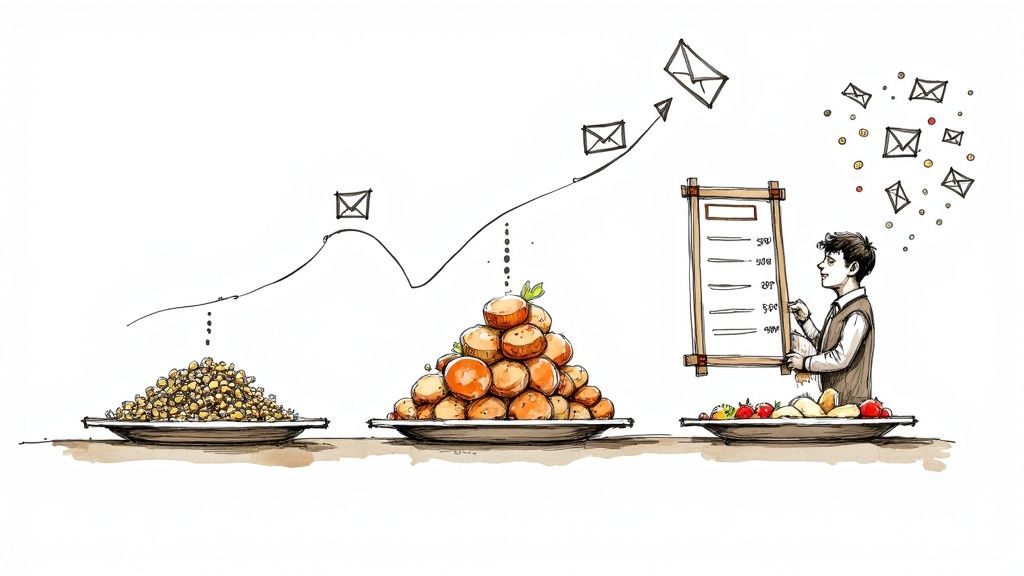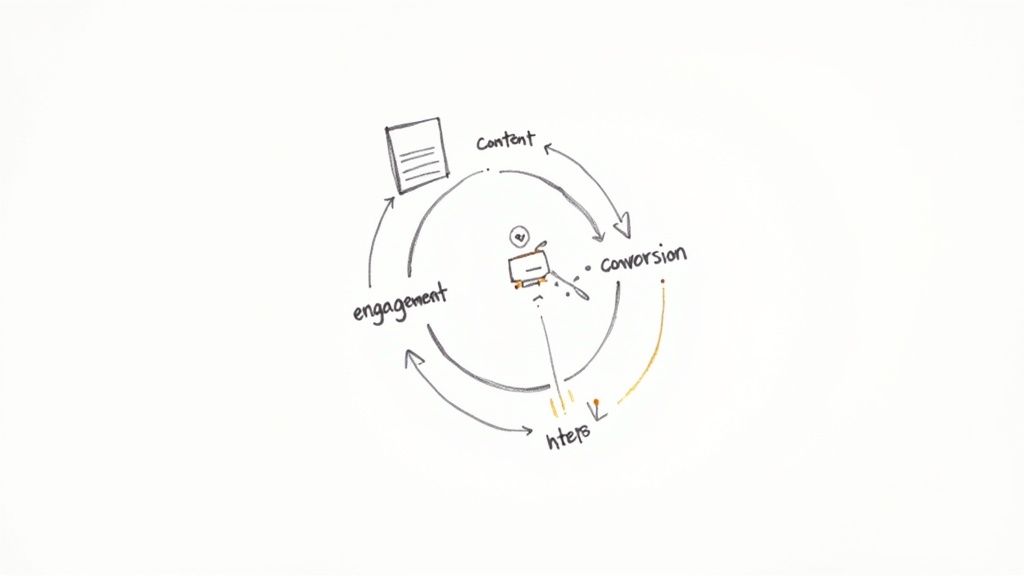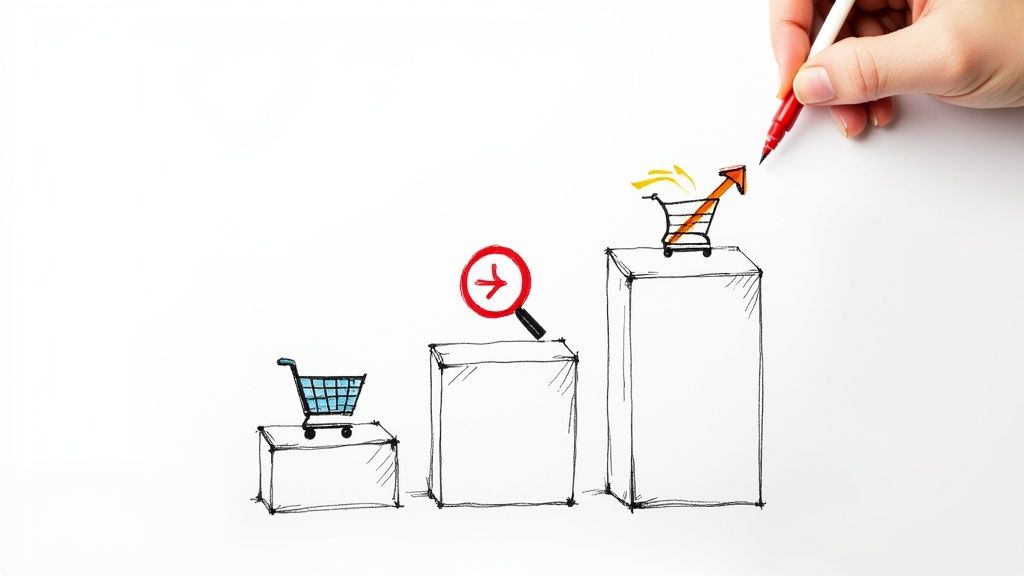Boost Your ROI with the Marketing Efficiency Ratio

16 mins
6/5/2025
Joe Ervin
- marketing efficiency ratio
- ROI optimization
- marketing metrics
- performance analytics
- campaign optimization
Understanding Marketing Efficiency Ratio Fundamentals
The Marketing Efficiency Ratio (MER) is a vital metric for evaluating the return on your marketing investments. It provides a comprehensive overview of how effectively your marketing spend generates revenue. This includes everything from social media campaigns and email marketing to SEO efforts. MER offers a broader perspective compared to metrics like ROAS (Return on Ad Spend), which focuses solely on advertising. Understanding MER is essential for making strategic decisions, allocating budgets, and ultimately, driving business growth.
Why MER Matters
Many marketers focus on surface-level metrics like clicks and impressions, sometimes losing sight of the ultimate goal: profitability. MER provides a direct link between marketing spend and revenue. For example, if you spend $1,000 on marketing and generate $5,000 in revenue, your MER is 5x (or 5:1). This simple calculation makes it easy to assess the effectiveness of your overall marketing strategy. A higher MER indicates your marketing efforts are generating substantial returns. A low MER, however, suggests potential inefficiencies that require further analysis.
Benchmarking Your MER
While a higher MER is generally preferred, the optimal target depends on factors like your industry, business model, and growth stage. A common benchmark for e-commerce businesses is an MER above 3x. This translates to generating $3 in revenue for every $1 spent on marketing. The Marketing Efficiency Ratio (MER) is a critical metric for assessing the overall return on marketing investment, regardless of how complex attribution is. Recent data suggests that maintaining an MER above 3x is a robust benchmark for global e-commerce companies.
Interpreting Your MER Results
A low MER isn't necessarily a sign of failure; it can highlight opportunities for improvement. It may indicate underperforming channels, inefficient campaigns, or issues within the conversion funnel. Analyzing MER alongside other metrics and data helps pinpoint areas for improvement and allows you to shift resources to more effective activities. This continuous process of measurement and optimization is key to maximizing your marketing ROI and achieving sustainable growth. Think of MER as a guide for your overall marketing strategy, helping you make data-driven decisions for the greatest impact.
Calculating Your Marketing Efficiency Ratio Like a Pro
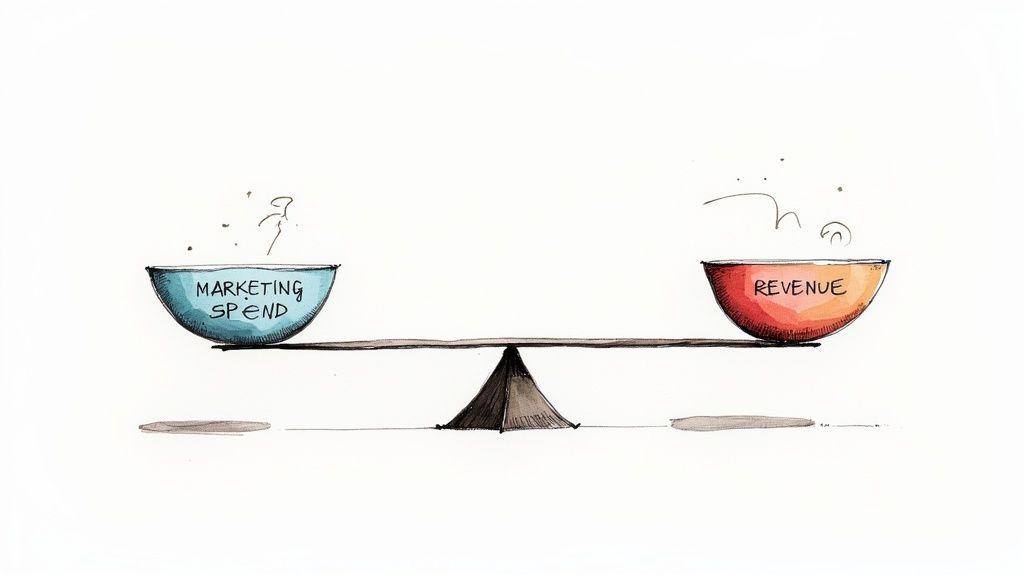
Calculating your Marketing Efficiency Ratio (MER) is a crucial step in understanding your marketing ROI. The core formula is simple: Total Revenue / Total Marketing Spend. So, if you spent $2,000 on marketing and generated $10,000 in revenue, your MER is 5x. This means every dollar you invested brought in five dollars of revenue. However, getting a truly accurate MER involves a deeper dive than just this basic calculation.
Key Considerations for Accurate MER Calculation
Several nuances can significantly impact your MER calculation. Understanding these is vital for getting reliable and insightful results. We'll explore key factors like identifying the right revenue streams, maintaining consistent time periods, and ensuring all costs are included.
Revenue Attribution: Properly attributing revenue to specific marketing activities is key. If a customer interacts with multiple touchpoints before buying, how do you assign credit? Multi-touch attribution models can help by considering the influence of different channels throughout the customer journey.
Time Period Consistency: Consistency in timeframes for both revenue and spend is essential. Comparing January's revenue with February's marketing spend won't give you a true picture. Select a timeframe – monthly, quarterly, or annually – that aligns with your business cycles. This allows you to correlate investments directly with returns within the same period.
Comprehensive Spend Tracking: Include all marketing-related costs. This means not just ad spend, but also content creation, email marketing software, agency fees, and marketing team salaries. Missing even small expenses can inflate your MER, giving you a false sense of efficiency.
Practical MER Calculation Examples
To illustrate how MER works in practice, let's examine some real-world examples. These scenarios will showcase how various factors influence the final MER calculation. To better present this data, we've compiled a table summarizing key insights.
The following table provides a detailed comparison of MER calculations across different business models and industries:
| Business Type | Revenue Period | Marketing Spend | MER Result | Performance Level |
|---|---|---|---|---|
| E-commerce Store | Q1 2024 | $5,000 | 4x | Good |
| SaaS Company | FY 2023 | $20,000 | 2.5x | Needs Improvement |
| Local Service Business | June 2024 | $1,000 | 7x | Excellent |
As these examples show, MER varies significantly based on industry, business model, and individual campaign performance. A lower MER isn’t necessarily a sign of failure. It can highlight opportunities for optimization. A SaaS company with a lower MER, for instance, might concentrate on enhancing customer lifetime value to boost revenue. You might be interested in: How to master your ecommerce email flows for maximizing customer lifetime value and thus improving MER.
Setting Up Automated MER Tracking
Manually calculating MER is a tedious process. Fortunately, analytics platforms and marketing automation tools offer automated tracking. This not only saves you time, but also ensures data accuracy and gives you real-time insight into your marketing performance. Many platforms provide built-in features or integrations that streamline this process, enabling continuous MER monitoring.
Industry Benchmarks That Actually Matter
So, you've calculated your Marketing Efficiency Ratio (MER). Now what? Understanding how your MER compares to industry averages is essential for setting realistic goals and pinpointing areas for improvement. This means seeing how your performance measures up against others in similar situations. This benchmark comparison gives you valuable perspective when interpreting your own MER results.
Understanding Benchmark Variations
It's important to remember that MER benchmarks aren't universal. Several factors influence what constitutes a "good" MER for your specific business. Industry dynamics, company size, and even current market conditions all contribute. For instance, industries with high customer lifetime value, like Software-as-a-Service (SaaS), might accept a lower initial MER, expecting long-term revenue from recurring subscriptions. You might be interested in learning how to increase average order value to boost your MER.
Additionally, larger companies typically have more resources to invest in advanced marketing strategies, potentially resulting in higher MERs compared to smaller businesses. Market fluctuations, such as economic downturns or seasonal trends, can also affect overall marketing effectiveness, and, as a result, your MER. A 2022 industry report showed that top-performing e-commerce brands in the retail sector often achieved MERs between 3x to 5x across their digital marketing campaigns. Companies using data-driven approaches and omnichannel strategies often outperformed their competitors, sometimes achieving MERs as high as 7x or more. Find more detailed statistics here.
Setting Achievable Targets
Once you understand the elements affecting benchmark variations, you can set realistic MER targets for your own business. This involves analyzing your industry, comparing your performance to similar companies, and evaluating your specific business model. Begin by researching industry averages and identifying top performers. This research gives you a baseline for understanding what's achievable within your sector.
Evaluating Your Performance
Comparing your MER to industry benchmarks lets you accurately assess your position. If your MER is significantly higher than average, congratulations! This excellent performance suggests effective marketing practices. However, don't get complacent. Continuously track your MER and adjust your strategies to maintain this high level of efficiency.
If your MER is below the benchmark, it doesn't automatically signal failure. Instead, consider it a chance for improvement. Use this information to spot weak points in your marketing strategy and create a plan for growth.

Real-World Adoption Trends and Competitive Advantages

Smart businesses are increasingly using the Marketing Efficiency Ratio (MER) to measure marketing success. It's a move away from less meaningful metrics, like clicks and impressions, and toward a bigger picture of marketing ROI. Let's explore how using MER is changing the competitive landscape and producing real results.
The Growing Importance of MER
MER is more than just a trend; it's a strategic necessity. Companies that focus on MER have a better grasp of their marketing spending's true impact. This knowledge helps with data-driven decisions, leading to smarter budget allocation and, ultimately, higher profits.
For example, businesses using MER can quickly spot underperforming channels and shift resources to more successful strategies. This flexibility is essential in today's ever-changing market.
MER Adoption Across Industries
MER is gaining popularity across various industries. While some sectors adopted it earlier, there's a growing understanding of its value overall. Businesses that emphasize customer lifetime value, such as subscription services, find that MER enhances their current metrics. It provides a more complete view of long-term profitability.
This broader perspective allows for smarter investment in getting and keeping customers. A 2024 global survey revealed that 62% of businesses in developed markets use the Marketing Efficiency Ratio as a standard KPI. Learn more about MER at Mailchimp.
The Competitive Edge of Data-Driven Marketing
Companies with annual revenues over $50 million reported average MERs of 3.8x, while smaller companies averaged 2.2x. This difference highlights the competitive advantage of data-driven marketing. Larger companies often have more resources for advanced analytics tools.
In fact, businesses investing at least 5% of their marketing budget in advanced analytics were twice as likely to have MERs above the industry average. This investment leads to more accurate MER calculations, better understanding of customer behavior, and more effective marketing.
Seasonal Influences and MER
MER is a strong measure of overall marketing performance, but it's important to consider outside influences. Seasonal trends can significantly affect marketing efficiency. For example, e-commerce businesses often see higher MERs during peak shopping seasons.
Understanding these changes helps businesses set realistic goals and adjust strategies. By looking at seasonal trends, businesses can also find ways to take advantage of high demand and optimize spending for maximum impact.
Real-World Success Stories
Many companies have improved their marketing by consistently using MER. These real-world examples show the benefits of data-driven marketing measurement. One company increased overall marketing ROI by 20% after using MER tracking and improving channel strategies.
Another business cut marketing costs by 15% while maintaining revenue growth by finding and eliminating wasteful spending. These success stories demonstrate MER's power to boost profitability and long-term growth.
Proven Strategies to Optimize Your Marketing Performance
Optimizing your marketing efficiency ratio (MER) is crucial for sustainable business growth. It's about maximizing the return on every marketing dollar spent. This isn't solely about boosting revenue; it's about achieving that growth with the utmost efficiency. This section offers practical strategies to elevate your MER and enhance your overall marketing performance.
Strategic Channel Optimization
Different marketing channels yield varying results. Some channels might be highly effective for your specific target audience, while others might deliver minimal returns. Analyzing your marketing data to pinpoint high-performing channels is the essential first step. This allows you to prioritize these channels and allocate your budget strategically.
For instance, if email marketing consistently outperforms social media advertising for your e-commerce brand, shifting resources to enhance your email strategy could dramatically improve your MER.
Precision Audience Targeting
Connecting with the right audience with the right message is paramount for marketing efficiency. Broad targeting can result in wasted ad spend and a lower MER. Instead, leverage data-driven insights to develop highly targeted campaigns that reach the most qualified prospects.
This involves crafting detailed buyer personas and segmenting your audience based on demographics, interests, and behavior. By focusing on the customers most likely to convert, you maximize the impact of your marketing budget. Check out this guide on e-commerce customer retention for more information.
Systematic Creative Testing
Ongoing A/B testing is essential for optimizing your creative assets and boosting your MER. This involves testing various elements of your campaigns, such as ad copy, images, calls to action, and landing page design.
By systematically testing different versions, you can determine what resonates most effectively with your audience and drives the highest conversions. Even small improvements can have a significant cumulative impact on your MER.
Campaign Timing Refinement
The timing of your marketing campaigns can greatly influence their success. Analyzing customer behavior and pinpointing optimal times to engage your target audience can significantly improve your MER.
This could involve sending emails when open rates are highest or scheduling social media posts during peak engagement periods. By refining campaign timing based on data-driven insights, you can boost conversions without increasing your spending.
Advanced Optimization Techniques
Integrating predictive analytics, automated bidding optimization, and cross-channel performance enhancement can further refine your marketing efficiency. Predictive analytics helps anticipate future customer behavior and personalize your marketing accordingly.
Automated bidding optimizes your ad spend in real-time, ensuring you get the most value from your budget. Google Ads offers robust automated bidding strategies. Enhancing performance across various channels allows for cohesive messaging and a more effective customer journey.
The following table provides a detailed overview of MER optimization tactics categorized by their potential impact:
MER Optimization Tactics by Impact Level
Comprehensive breakdown of optimization strategies ranked by potential impact and implementation difficulty
| Strategy | Impact Level | Implementation Time | Required Resources | Expected MER Lift |
|---|---|---|---|---|
| Strategic Channel Optimization | High | Medium | Data analysis | Significant |
| Precision Audience Targeting | High | Medium | Customer data | Significant |
| Systematic Creative Testing | Medium | Low | A/B testing tools | Moderate |
| Campaign Timing Refinement | Medium | Low | Analytics tools | Moderate |
| Advanced Optimization Techniques | High | High | Specialized tools | High |
| Eliminating Inefficient Spend | Medium | Low | Spend data | Moderate |
This table summarizes the various strategies, their potential impact on MER, and the resources required for implementation. Focusing on high-impact strategies first can lead to the quickest and most significant MER improvements.
Identifying and Eliminating Inefficient Spending
Regularly auditing your marketing spend and identifying areas of inefficiency is crucial for improving your MER. This might involve cutting underperforming campaigns, renegotiating contracts with vendors, or consolidating tools and services.
By eliminating wasteful spending, you liberate resources to invest in more effective strategies and improve your overall marketing ROI. A consistent focus on optimizing your marketing mix and implementing systematic testing frameworks will drive continuous MER improvement. You might also find this resource helpful: How to master your e-commerce customer retention.
Avoiding Critical Marketing Efficiency Mistakes
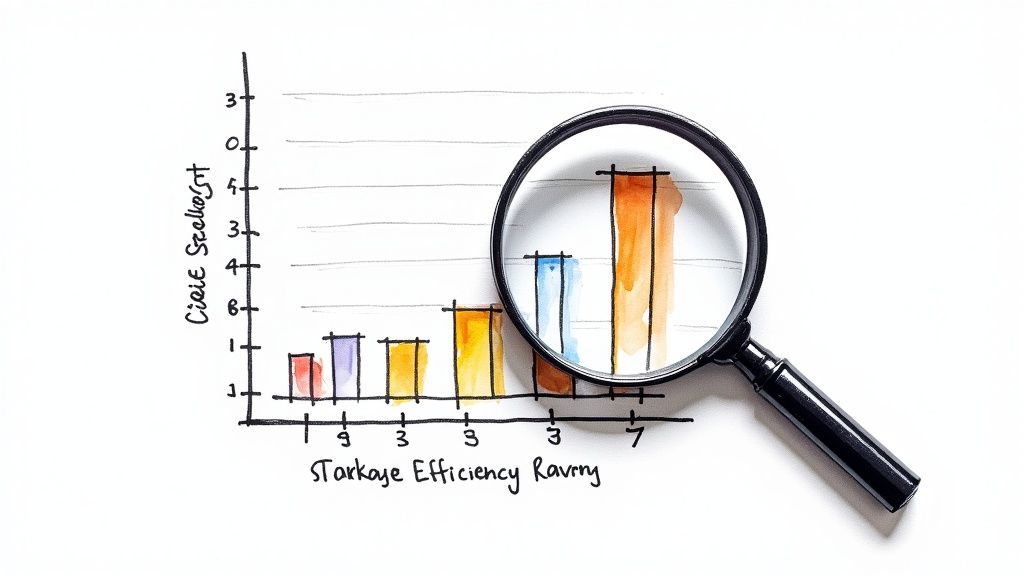
Maximizing your marketing efficiency ratio (MER) is a crucial aspect of any successful marketing strategy. It's not enough to simply implement the right strategies; you also need to avoid common pitfalls that can sabotage your efforts. This section explores some of the most critical mistakes that can hinder your progress and offers practical solutions to keep your marketing performance on the right track.
Common MER Calculation Errors
One of the most basic, yet often overlooked, mistakes is incorrectly calculating the MER itself. This often arises from neglecting key elements within the formula or using inconsistent data.
For instance, failing to include all marketing expenses, from small software subscriptions to larger agency fees, can create an inaccurate picture of your MER, making it appear higher than it actually is. Similarly, comparing revenue from one period with marketing spend from a different period creates a mismatch that distorts the ratio.
To ensure accurate MER calculations, meticulously track all marketing-related costs. Maintain consistent timeframes for both revenue and spend data. This provides a clear and reliable foundation for assessing marketing performance.
Data Interpretation Pitfalls
Even with precise calculations, misinterpreting your MER results can lead to poor decision-making. A low MER doesn't automatically signify overall marketing failure. It might simply indicate underperforming channels or specific campaigns that need attention.
For example, a highly successful email marketing strategy might be masking weaknesses in your paid advertising campaigns. Therefore, it's crucial to analyze your MER alongside channel-specific data to identify the true source of inefficiencies. This targeted approach enables you to address specific problems rather than making sweeping, and potentially detrimental, changes to your entire marketing strategy.
Strategic Missteps That Impact MER
Several strategic missteps can have a significant negative impact on your marketing efficiency ratio. One common oversight is neglecting customer retention. Acquiring new customers is typically more expensive than retaining existing ones. Focusing solely on acquisition while neglecting retention efforts can lower your MER and ultimately impact your bottom line.
Another common pitfall is failing to adapt your strategies to evolving market conditions. What delivered results last quarter might not be effective in the current market. Continuously monitor your MER and be prepared to adjust your strategies based on current market dynamics and shifts in customer behavior.
Learning From Real-World Examples
Examining real-world examples can offer valuable insights into the complexities of MER implementation. One e-commerce brand experienced a substantial drop in MER after introducing a new product line. They initially attributed this to the increased marketing spend associated with the launch. However, a more thorough analysis revealed that the decline stemmed from poor product-market fit, not ineffective marketing. This highlights the importance of considering external factors that can influence MER.
Another company witnessed a steady decline in their marketing efficiency ratio due to neglecting customer retention. While they heavily invested in acquisition, their customer churn rate was high, leading to an overall decrease in profitability. Implementing a robust customer retention strategy helped them increase customer lifetime value and significantly improve their MER.
Diagnostic Frameworks and Corrective Strategies
Utilizing diagnostic frameworks can help pinpoint potential issues affecting your MER. These frameworks typically assess key aspects of your marketing performance, such as channel performance, audience targeting, and creative effectiveness. Identifying weaknesses in these areas allows you to implement targeted corrective strategies.
For example, if analysis reveals ineffective audience targeting, you can refine your targeting parameters, develop more specific customer segments, and tailor your messaging to resonate with those segments. Regularly reviewing your marketing data, implementing appropriate corrective actions, and utilizing resources like Trace, which offers email marketing and social media strategies specifically for e-commerce brands, are proactive steps essential for improving and maintaining a healthy marketing efficiency ratio.
Key Takeaways
Your journey to mastering marketing efficiency goes beyond simple calculations and benchmarks. Real success lies in using these insights to fuel actual business growth. This section highlights key strategies and actionable steps you can implement today to optimize your marketing efficiency ratio (MER) and strengthen your competitive advantage.
Prioritize High-Impact Activities
Concentrate your resources on activities that provide the greatest return. This requires a data-driven approach to channel optimization, audience targeting, and campaign timing.
Channel Optimization: Pinpoint your best-performing channels. For an e-commerce business, this could be email marketing or a particular social media platform like Instagram. Focus your resources on maximizing the impact of these channels. If email marketing consistently outperforms paid advertising, for instance, shift more of your budget and effort toward improving your email strategy.
Audience Targeting: Precise targeting ensures your message reaches the right people. Develop detailed buyer personas and segment your audience based on demographics, interests, and online behavior. This focused approach minimizes wasted ad spend and maximizes conversions, directly improving your MER.
Campaign Timing: Optimize the timing of your campaigns based on data insights. This could involve sending emails when open rates are highest or scheduling social media posts during periods of peak user engagement. Aligning your outreach with customer behavior maximizes impact without increasing spending.
Implement Continuous Optimization
Marketing efficiency is an ongoing process, not a one-time fix. Continuously analyze your MER and other relevant metrics, adapt to changing market conditions, and regularly test new approaches.
Regular Data Review: Go beyond just calculating your MER; analyze it. Regularly review your marketing data to identify trends and areas for improvement. A declining MER, for example, might suggest a need to refresh your creative content or adjust your targeting.
Market Adaptation: Remain adaptable. Market conditions and customer behavior are always evolving. Be ready to adapt your strategies to maintain optimal efficiency. This could involve exploring new marketing platforms, refining your messaging, or reallocating budget based on current trends.
Systematic Testing: A/B testing is crucial for continuous improvement. Test different versions of your ads, emails, and landing pages to determine what resonates best with your audience. Small changes can lead to substantial MER improvements over time.
Leverage Automation and Technology
Use automation and technology to streamline your processes, enhance accuracy, and improve your decision-making.
Automated Tracking: Move away from manual calculations. Utilize analytics platforms and marketing automation tools like HubSpot for real-time MER tracking and data analysis. This provides immediate insights into your marketing performance, enabling quicker adjustments and greater efficiency.
Advanced Analytics: Invest in advanced analytics solutions to gain deeper insights into customer behavior, channel performance, and campaign effectiveness. This data-driven approach empowers more informed decisions and more targeted optimization strategies.
Integrated Platforms: Choose platforms that seamlessly integrate with your current systems. This streamlines data flow and reduces manual work, freeing up your team to concentrate on strategic marketing initiatives.
Focus on Customer Retention
Acquiring new customers is essential, but retaining existing customers is even more vital for sustained growth and a healthy MER. Repeat customers often generate more revenue with lower marketing costs.
Loyalty Programs: Implement loyalty programs to reward repeat customers and foster continued engagement. This increases customer lifetime value and improves your MER by generating more revenue from your current customer base.
Personalized Communication: Tailor your communication to individual customer preferences and past behavior. This personalized approach strengthens customer relationships and increases retention.
Customer Feedback: Regularly collect customer feedback and use it to improve your products, services, and marketing efforts. Satisfied customers are more likely to remain loyal, contributing to a higher MER and continued business growth.
Learn from Mistakes
Mistakes are unavoidable, but they provide valuable learning opportunities. Analyze past errors to identify areas for improvement and prevent repeating them.
Data Interpretation: Be cautious about misinterpreting your MER. A low MER doesn't necessarily indicate overall marketing failure; it might highlight specific weaknesses in individual campaigns or channels.
Strategic Missteps: Learn from past strategic mistakes. These might include overspending on ineffective channels, neglecting customer retention efforts, or failing to adapt to changing market dynamics.
Diagnostic Frameworks: Implement diagnostic frameworks to identify potential issues and implement corrective strategies before they significantly impact your MER.
By implementing these key takeaways and consistently refining your strategies, you can achieve lasting improvements in your marketing efficiency ratio and drive substantial, long-term business growth. For e-commerce businesses looking for specialized strategies and expert guidance, consider how Trace can optimize your email marketing and social media campaigns for maximum impact.


